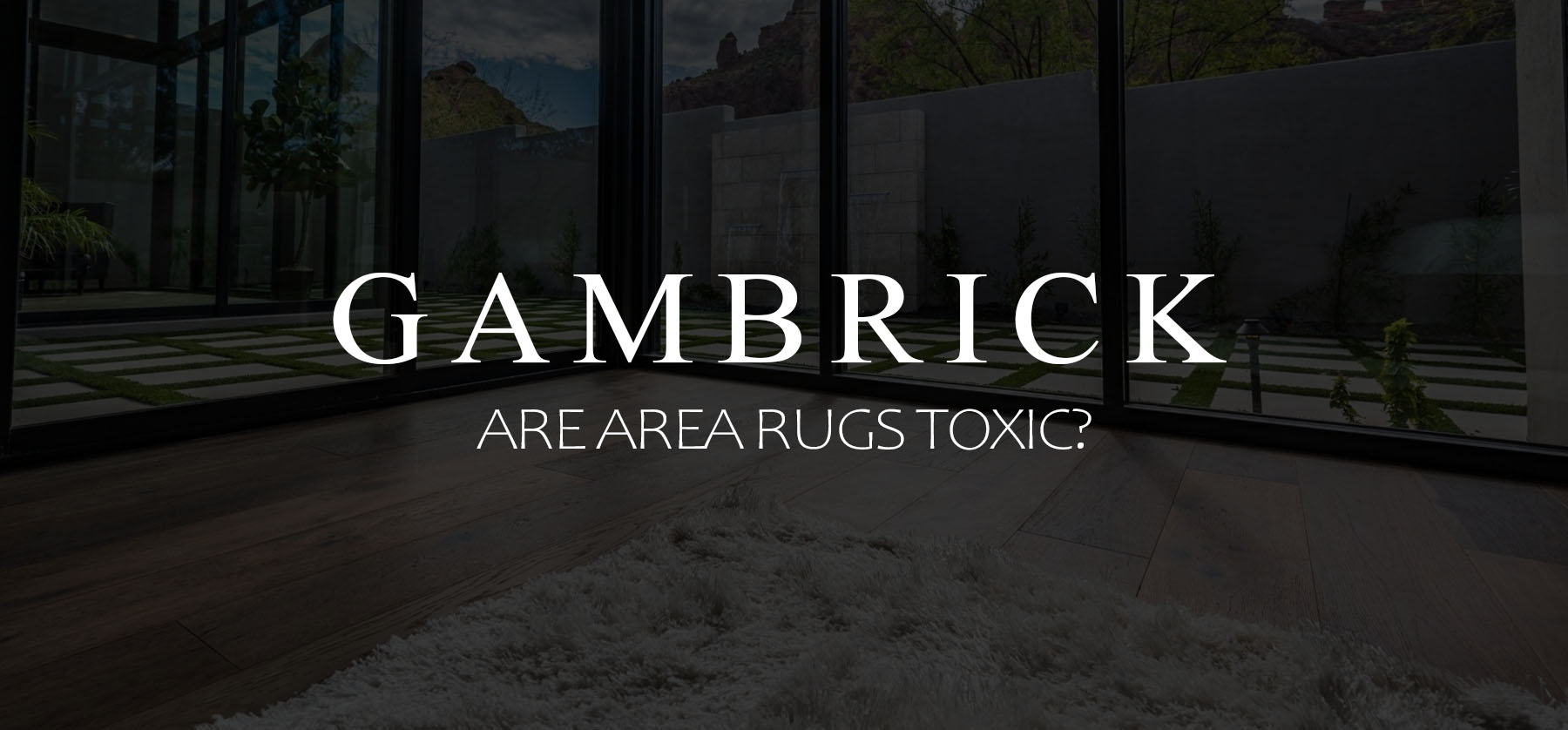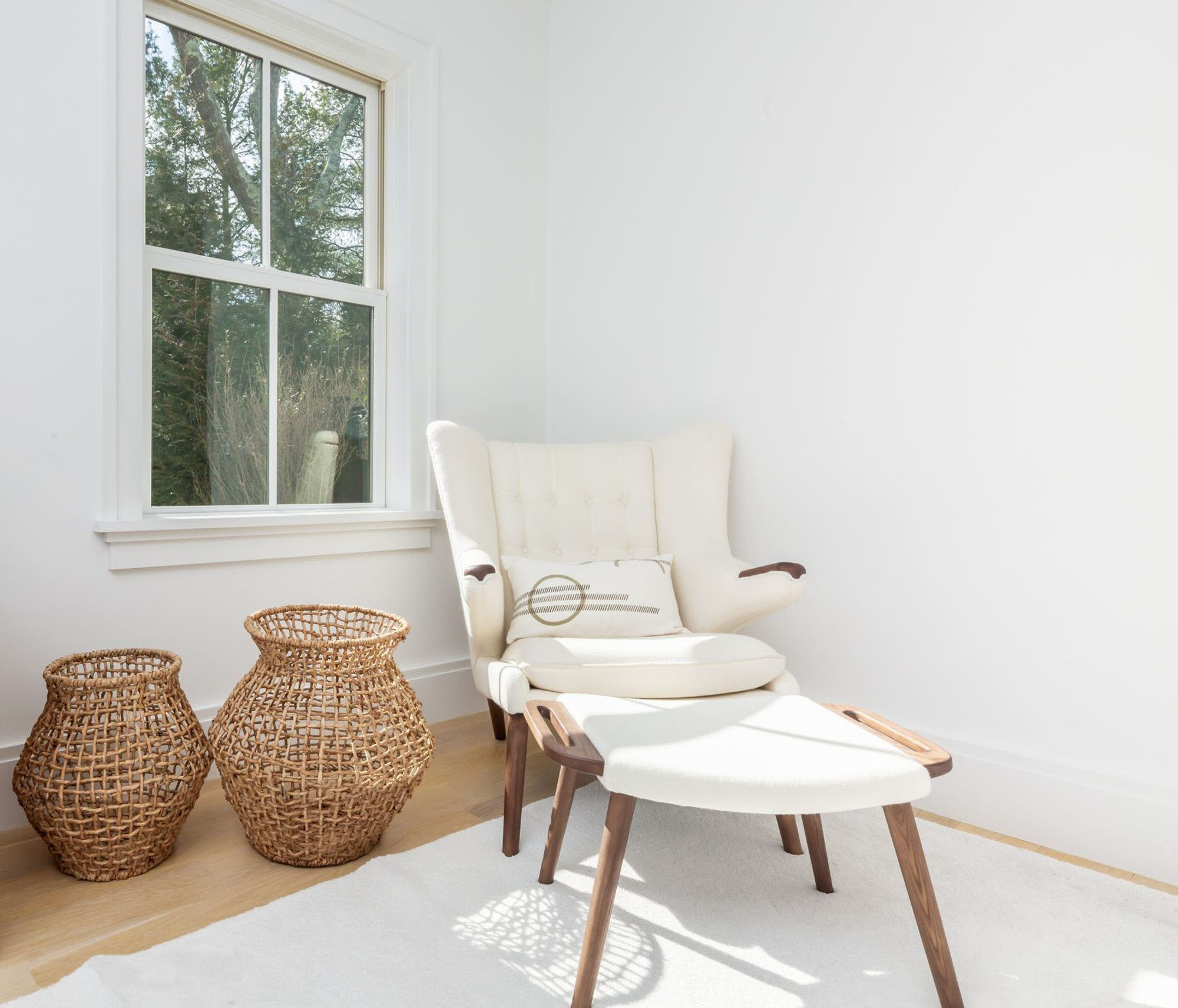Are Area Rugs Toxic?
You may not realize this, but the majority of synthetic area rugs and even some that are made from natural fibers do contain toxins.
It was hard for me to believe at first, but the majority of synthetic area rugs and even some made from natural fibers sold every day at department stores and online contain toxic chemicals. Toxic area rugs are so common that you actually have to make an effort to find one that’s certified as non toxic. With today’s interior design trend being hardwood floors throughout and lots of area rugs, it’s a big problem when the majority of those rugs contain potentially harmful chemicals. Unfortunately, area rugs are one of the largest contributors of toxins inside your home. In fact, California Department of Toxic Substances Control has listed carpets and rugs as the largest potential sources of significant and widespread PFAS exposures. And then you have VOCs and other chemicals to worry about.
This may not be a huge problem for your average adult, but if you have small kids that regularly play on the floor then it’s a major issue. I’d bet if most homeowners knew what was actually in the area rug they were buying then they probably wouldn’t.
The good news is that there are plenty of options. It’s easy to have a beautiful home full of area rugs that are Eco friendly and free of toxic chemicals. In this article we’ll discuss what’s actually toxic about most area rugs and give you some information on how to find rugs that are safe.
Entry way area rug made from natural sisal fibers with a casual border. Tightly weaved rugs are great for areas with heavy foot traffic.
What Makes An Area Rug Toxic?
The vast majority of area rugs sold are made from polyester, polypropylene, acrylic, nylon, or other synthetic materials that are full of toxins. They’re usually dyed with chemical colorants and backed with synthetic rubber, PVC, and chemical adhesives. Most are also treated with formaldehyde, pesticides, and other chemicals to make them stain proof, moth repellent, fire retardant, and water repellent.
Even cotton, wool, and other natural materials can be grown organically, but then treated with chemicals later. Most rugs are filled with toxins.
If you want a non-toxic area rug then there are a few factors to consider.
Just because the marketing says a rug is free of a certain compounds or materials doesn’t mean it’s completely non-toxic. Marketers are very sneaky. They often take out one chemical to say they’re non-toxic and then use another that’s just as bad or worse.
One of the ways we check our rugs before using them is the smell test. Many rug manufacturers will state their rugs are toxin free but their referring to the manufacturing process and not the cleaning or coloring of the rug.
Many rugs receive stain resistant treatments or dyes after the rug is made which contain all sorts of chemicals. You can always find these because of the strong chemical smell. The odor on some of these area rugs is so bad that you have to air them out for days before bringing them inside. The smell does eventually go away but it’s something I wouldn’t want my kids playing on.
Make sure you choose a truly non-toxic rug and always look for reviews mentioning the smell when they’re new. Companies will air the rugs out to hide the smell before selling them but no matter what they do many of them still have a chemical odor.
Common Toxins In Area Rugs
- Materials like polypropylene, nylon, and polyester. These are all synthetic materials created with chemicals. Synthetic materials aren’t always harmful but we’d stay away from them as much as possible. Any rug that’s made from primarily synthetic fibers should be avoided.
- Flame retardant materials. These are very toxic and don’t really work that well anyway. Anything that says flame retardant I’d stay away from because it’s done via a chemical treatment.
- Natural materials like cotton and wool. Believe it or not even natural materials can sometimes be a problem. If natural materials aren’t carefully sourced then they can be full of pesticides and other agricultural chemicals, as well as chemicals used in the manufacturing process.
- Synthetic rubber backing. The rubber bottom of some rugs can contain chemicals.
- Dyes. Many rugs contain very strong dyes that leave chemical residue behind after manufacturing. These chemicals can leach into the skin and can often smell very bad.
- Formaldehyde. It’s commonly used to make an adhesive that’s used to manufacture some area rugs.
- Stain and water repellent treatments. More chemicals that can leach and be absorbed through the skin. Avoid any type of area rug treatment because they’re typically done with chemicals.
Beware of VOCs
Synthetic carpets contain volatile organic compounds a.k.a. VOCs. These are the compounds that make that that “new carpet” smell. And they may attribute to health problems ranging from allergies to nausea and who knows what else.
Virtually all synthetic rugs are backed with a latex mix containing styrene which is a possible human carcinogen.
If you want a healthier home with better air quality then stay away from anything synthetic or containing any VOCs. If you do buy a rug containing VOCs then air it out thoroughly before bringing it into the home You’ll know your rugs has them because it’ll smell really bad like a new rug.
You may not realize it, but that new rug smell is coming from chemicals within the rug being aired out into your home. You literally can small the chemical fumes coming from the rug. How can anyone think that’s a good thing to be breathing in.
And those fumes don’t go away just because you don’t smell them anymore. It’s still in the air being breathed in but at a lower dose you don’t notice anymore, or maybe have just gotten used to. I can’t stress this enough, if you buy a rug that smells like a rug, then air it out in the sun for a few days and give it a good wash before bringing it inside.
Printed runner style area rug made with natural fibers and no harsh chemicals.
Are Eco Friendly Rugs & Non Toxic Rugs The Same?
Eco friendly rugs and non toxic rugs are both an upgrade from your standard department store rug that’s neither of these things, however, they’re each designed for a totally different purpose.
Eco-friendly rugs are made in a way that focuses on being environmentally friendly. They may use recyclable materials for example. The idea of Eco friendly rugs is to be green and has nothing to do with being non toxic. Lot’s of products that are labels Eco friendly still use chemicals in the manufacturing process that makes it’s way into the finished product. And while these types pf rugs may be safer for the environment, they’ll still bring unwanted toxins into your home.
Non-toxic rugs are created using materials and manufacturing processes focused on the health of the people that use the rug. These rugs are much safer and don’t contain unwanted chemicals. However they’re not necessarily Eco friendly.
When shopping for a non-toxic rug, you’ll eventually come across claims like “green”, “sustainable”, or “Eco-friendly”. While these features may be good for the environment, they don’t necessarily mean they’re safer for you and your family’s health. Don’t be confused when you see these terms on the label because they don’t have much to do with being non-toxic.
It’s important to note that an Eco friendly rug can be non toxic and a non toxic rug can also be Eco friendly. If having both of these features in one product is important to you then you’ll be happy to know there are rugs on the market that deliver on both counts. Make sure the label or product information clearly states that the rug is a “green” product and has been tested and found to be toxin free.
Natural Non Toxic Rugs Are Best
Ideally you’ll want an area rug that’s made from natural materials. It’s fibers should be grown, or raised, without pesticides, herbicides, and other chemical additives. You’ll also want to make sure the yarn, fabric, and finished rug were not manufactured with any harsh chemicals.
Examples of healthier rug materials include (chemical-free) cotton, wool, sea grass, mohair, jute, and sisal. These materials are beautiful in their natural undyed state or dyed naturally, using plant based colorants such as indigo or henna.
Try and find a rug that’s free from any glues.
Look for natural rug and carpet backings that’s made from hemp, cotton, or natural latex, instead of PVC or man made chemical rubber.
What Rug Material Is Best?
If your looking for an Eco-friendly, non-toxic rug material then what you want is wool. It’s sustainable and unless treated or dyed at the factory, non-toxic.
Some other natural materials that make great non-toxic carpets are (chemical-free) cotton, wool, sea grass, mohair, jute, and sisal.
Just make sure to choose material that hasn’t been treated with any additional chemicals. Stay away from anything that says stain resistant, water resistant, or that smells like a strong dye. Basically you want a 100% natural rug without any type of treatment or added resistance because those things are created with chemicals.
Rug pads also come in natural fibers like wool, latex or natural rubber. Stay away from chemical rubbers.
Finally, if you can’t avoid using a synthetic carpet, check out brands that are vetted by a third party. There are companies that test products and certify them as Eco-friendly or non-toxic. However be careful because these companies don’t always test for every type of chemical so read the fine print and make sure what you buy is 100% non-toxic. The certification we look for cover the rug from raw fiber to finished product. We’ll talk more about this later.
Thin, natural area rug made from all natural materials and no dyes. Chemical free and non-toxic.
What To Do If My Rugs Not 100% Non-Toxic
Unfortunately, if you own an area rug then chances are it contains some level of unwanted and potentially harmful toxins. So what can you do about it now? The following tips can help. Keep in mind these are for rugs you already own or area rugs that are sold as non-toxic but still may not be completely free of all toxins.
We highly recommend you buy a rug that doesn’t have any of the chemicals or materials we listed above.
What can I do if my area rug isn’t totally non-toxic?
Have you ever heard the turn “off gassing.” It means to take a rug and let it sit outside in the sun and fresh air. This airing out process helps any harmful gasses and odors come off and out of the rug. This is especially beneficial if your rug has a chemical odor.
We recommend doing this with any area rug you buy. Even it says non-toxic or Eco-friendly, we still air them out before bringing them inside just in case. Toxins and chemicals are so commonly used in the rug making industry that it’s worth being a little extra careful.
How can I get rid of bad chemical odors?
Baking soda is a great way to remove any annoying chemical odors from the rug. these are generally caused from dyes used in the manufacturing process.
Sprinkle baking soda all of the rug and let it sit for a day or so. Then vacuum the rug clean.
We recommend doing this in addition to airing the rug out in the sun. The combination of both techniques is a good way to deal with
Wash The Rug
It’s OK to wash your rug out. We recommend a basic wash with soap and hot water. As hot as the material will allow. My grandmother used to use boiling hot water to wash all the germs and bacteria out of her rugs. Steam cleaning are also an effective technique. Use a good sudsy soap and a scrub brush.
After the rug is washed thoroughly make sure you rinse it out and then let it dry. Don’t bring it inside until it’s completely dry.
A good washing with soap and hot water along with airing out can be a big help. Although, just like with the techniques listed above, washing won’t remove harmful chemicals or materials from your rug. We recommend you buy a non toxic rug and then do these cleanings in addition just in case.
Pro Tip: Stay away from chemical cleaners. Many commercial rug cleaners on the market contain chemical cleansers and not soap. What’s the point of buying a non-toxic rug if you put the chemicals in later anyway. We recommend simple soap and as hot a water as your rug material can handle.
Thin area rug made from natural materials without any dyes or harsh chemical additives.
How Do I Know If My Rug Is Non-Toxic?
Natural rugs should be certified organic and 100% free of toxins. This certification should be by a third party that test the rug and it should cover every stage of manufacturing from raw fiber to finished product. The big names in certified textiles include OEKO-TEX, Greenguard, and the Global Organic Textile Standard (GOTS).
The organic certification is unfortunately quite expensive. As a result, so are the area rugs that carry this certification.
To keep costs down, some brands will source their fibers from suppliers that follow organic practices but do not hold the organic certification. In my opinion this is better than nothing but not as good as an inspection and certification of the entire product from start to finished product.
By An Old Or Antique Wool Rug
Personally, I only buy old antique wool rugs. They’re super durable, look great and don’t contain any chemicals or harmful toxins.
Now a days everything is so commercialized. Manufacturers add chemicals to just about everything. In the past this wasn’t the case. I have rugs that are over 100 years old, still look brand new and they’re absolutely 100% non-toxic.
Plus antique rugs bring a style to my interior designs that new rugs really can’t match.
You should still do a little research on the type of rug, material and manufacturer. Just because it’s old doesn’t necessarily guarantee it’s 100% toxin free. I like to buy old rugs that were hand made out of real wool and undyed because there’s very little chance chemicals were ever used.
What’s the best way to care for your new non-toxic rug?
Once you’ve put n the time and found the perfect non-toxic rug, you’ll want to care for it properly so it’ll last. Here are a few ways to do it:
- Use a rug pad. While we do recommend you use a rug pad, we don’t mean the toxic ones made out of rubber. A good rug pad can help protect your rug because it helps keep it in place. Without a rug pad the area rug can slide around and catch a sharp edge somewhere. I recommend using felt or wool rug pads or something made from 100% natural latex.
- Don’t use a brush roll vacuum. One of the worst things you can do to your rug is use a vacuum’s brush roll. It’s terrible for the rug and can really chew them up. Rugs are made from lots of small fibers. The brush roll spins and pulls at the fibers which can easily damage the rug.
- Clean Your Rug. Gently wash your rug and air dry it out as needed.
- Take shoes off. This tip isn’t for everyone but it does help care for your rugs a little bit. And it has the added benefit of not bringing in germs or toxins from the bottom of your feet. If you think about it, how dirty are some of the grounds that we walk on every day? Ever been in a public bathroom lately. Then we walk around the rugs our kids play on with those same filthy shoes. It’s kind of gross.
If put out the effort to care for your non-toxic area rug properly then it can last for decades.
Summary: Are Area Rugs Toxic?
You may not realize this but the majority of commercially produced area rugs are toxic.
This may be hard for you to believe but the majority of area rugs sold at department stores and online contain toxic chemicals. Toxic area rugs are so common that you actually have to make an effort to find one that’s actually non toxic. Because today’s interior design trend of hardwood floors and lots of area rugs, it’s a big problem when the majority of those rugs contain potentially harmful toxins. Unfortunately, area rugs are one of the largest contributors of toxins inside your home. In fact, California Department of Toxic Substances Control has listed carpets and rugs as the largest potential sources of significant and widespread PFAS exposures. And then you have VOCs and other chemicals to worry about.
This may not be a huge problem for your average adult, but if you have small kids that regularly play on the floor then it’s a major issue. I’d bet if most homeowners knew what was actually in the area rug they were buying then they probably wouldn’t. The good news is that there are plenty of options. It’s easy to have a beautiful home with area rugs that are Eco friendly and free of toxic chemicals.
I hope the information in this article helps you research and buy a healthy, non-toxic area rug for your home.
If you have any questions or comments e-mail us any time. We’d love to hear from you.

























